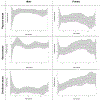Sensitive Periods for the Association Between Childhood Maltreatment and BMI
- PMID: 31542127
- PMCID: PMC7142333
- DOI: 10.1016/j.amepre.2019.05.016
Sensitive Periods for the Association Between Childhood Maltreatment and BMI
Abstract
Introduction: Although previous research has suggested a positive association between child maltreatment and BMI over the life course, it is unclear when this develops.
Methods: The authors used time-varying effect models and data from a nationally representative, longitudinal, cohort study (Add Health), to test how childhood physical, sexual, and emotional abuse uniquely varied in associations with BMI from age 13 to 28 years, and whether different patterns existed for male and female participants. Add Health collected data from 1994 to 2008, and the present analyses took place in 2018.
Results: Age 18 years was the earliest that a relationship between maltreatment and BMI emerged for either sex. Child sexual abuse was negatively associated with BMI among male participants from 18.5 to 20 years, but positively associated with BMI among female participants from 19 to 24.5 years, and childhood emotional abuse was positively associated with BMI among female participants from 18 to 28 years.
Conclusions: The relationship between child maltreatment and BMI varies as a function of type of maltreatment, sex, and time. Notably, associations between maltreatment and BMI did not emerge until young adulthood. Future research should investigate mechanisms by which the association between maltreatment and BMI changes over time to identify trauma-informed intervention targets for improving weight outcomes.
Copyright © 2019 American Journal of Preventive Medicine. Published by Elsevier Inc. All rights reserved.
Figures


References
-
- Sedlak AJ, Mettenburg J, Basena M, Peta I, McPherson K, Greene A. Fourth national incidence study of child abuse and neglect (NIS-4). Washington, DC: US Department of Health and Human Services; Retrieved on July 2010;9:2010.
-
- Stoltenborgh M, Bakermans-Kranenburg MJ, Alink LR, IJzendoorn MH. The prevalence of child maltreatment across the globe: Review of a series of meta-analyses. Child Abuse Review. 2015;24(1):37–50.
-
- Danese A, Tan M. Childhood maltreatment and obesity: systematic review and meta-analysis. Molecular psychiatry. 2014;19(5):544–554. - PubMed
-
- Dong M, Giles WH, Felitti VJ, et al. Insights into causal pathways for ischemic heart disease adverse childhood experiences study. Circulation. 2004;110(13):1761–1766. - PubMed
Publication types
MeSH terms
Grants and funding
LinkOut - more resources
Full Text Sources

